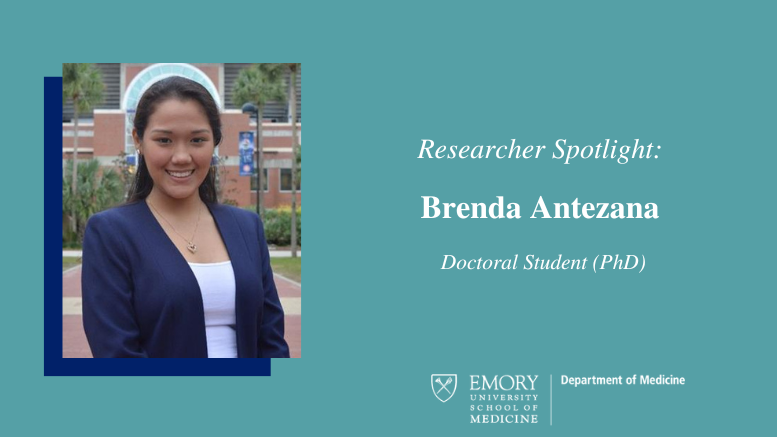Doctoral Student (PhD)
2022 DOM Research Day – Best Poster Presentation (Basic Science Research)
What is your professional background?
I completed my undergraduate education at the University of Florida (UF) in Gainesville, Florida and majored in chemistry with an emphasis on biochemistry. However, infectious diseases have always interested me, so I joined Dr. Amy Vittor’s laboratory in UF’s Emerging Pathogens Institute as a research assistant and lab manager. My main project consisted of developing novel field methods to identify mosquito vectors that transmit, and rodent host species that sustain, alphaviruses or flaviviruses. I also contributed to another project where we sought to characterize early infection processes and antiviral immune responses to Mayaro viral infection. This infectious disease research experience at UF propelled me to attend graduate school and now here I am – a PhD student in Emory’s Microbiology and Molecular Genetics (MMG) program in the Graduate Division of Biological and Biomedical Sciences.
In what division do you work, and who is your mentor?
As a PhD student in the MMG program, I am technically in the Laney Graduate School. However, my mentors are Dr. David Stephens and Dr. Yih-Ling Tzeng, both of whom are in Emory’s Department of Medicine, Division of Infectious Diseases.
Briefly describe your research. Why is it important?
My research focuses on investigating the molecular mechanisms for horizontal transfer of antibiotic resistance in Streptococcus pneumoniae, a bacterial pathogen that continues to affect children, the elderly, and immunocompromised individuals. Although it is known that large Tn916-related integrative and conjugative elements (ICEs) are found integrated in the genome of S. pneumoniae and confer macrolide and tetracycline resistance, the mechanism by which these elements are spreading is poorly understood. We have utilized a continuous flow bioreactor system to investigate the exchange of these ICEs in dual-strain biofilms that formed on human nasopharyngeal cells, a model that mimics the natural colonization of S. pneumoniae in the upper respiratory tract. Additionally, we have been exploring the role of secreted extracellular vesicles from S. pneumoniae as another mechanism for horizontal spread of antibiotic resistance as opposed to the extensively studied mechanisms of conjugation via secretion systems, transformation of extracellular DNA, or transduction mediated by bacteriophages. Understanding the dynamics associated with the horizontal dissemination of antibiotic resistance may aid in developing better strategies to get ahead in the arms race that exists between bacteria and humans to allow us time to create novel treatments.
What do you like most about Emory?
My time at Emory has taught me the importance of human connection, networking, collaboration, and mentorship. I really enjoy engaging with the faculty and staff and have been able to acquire advice for career development as well as for scientific investigation.
What is your favorite movie or TV show?
I could watch any of the 1980s Indiana Jones movies over and over again, but I also love the classic Homeward Bound: The Incredible Journey (1993).
What do you like to do in your spare time?
My favorite activities to do in my spare time include spending time outdoors, whether it be hiking, camping, paddle boarding, kayaking, or simply lounging around on a picnic blanket or in a hammock with my dog.
What is a fun fact about you?
I was able to go up on stage to dance and sing with a well-known huayno (traditional Andean music) artist, Sonia Morales, during her concert in Miami, Florida!


Be the first to comment on "Researcher Spotlight: Brenda Antezana"